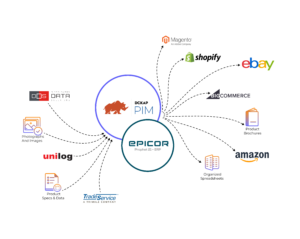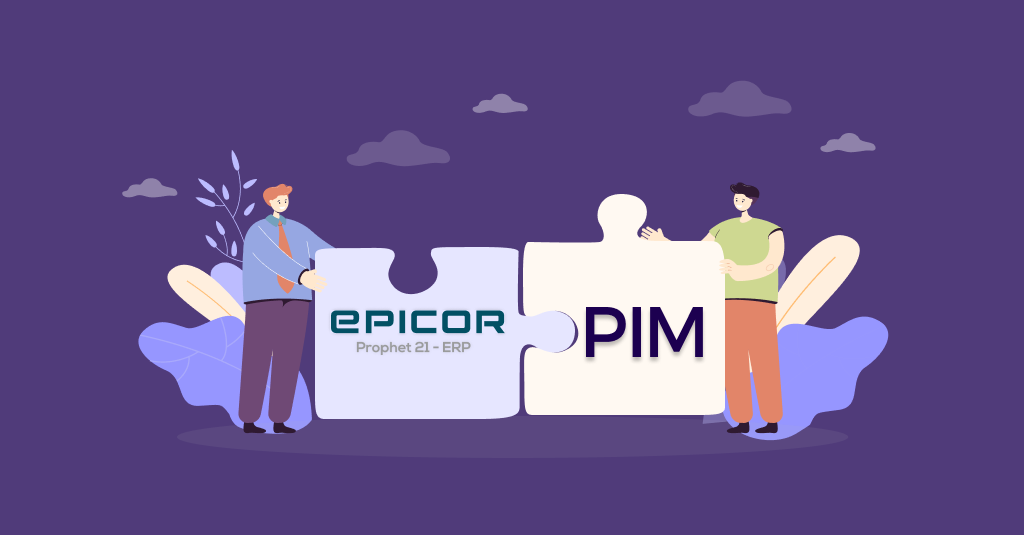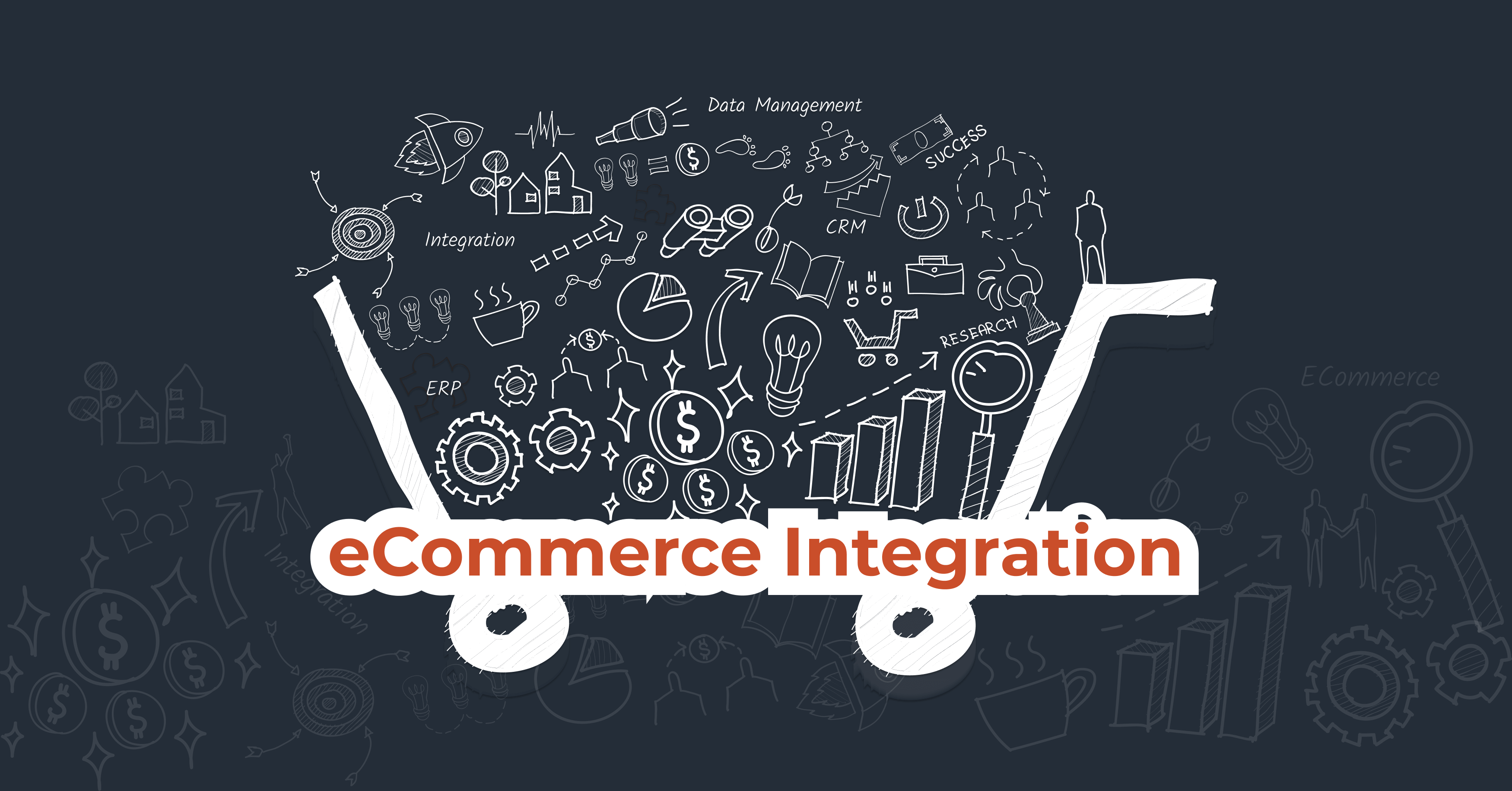Any business communication can be split into two categories: ones that are executed to help the business function better, and those that help communicate with their audience better.
A distribution business, like many, has a lot going on. Smart businesses have an ERP in place to help keep track of these on an ongoing basis and make effective business decisions as and when required. Epicor Prophet 21, for example, helps modernize the approach to various aspects of a distribution business: from shipping and inventory management, all the way to accounting and customer support.
The jack of many trades can often benefit from a specialist’s support. In this case, that’s the role a Product Information Management (PIM) tool plays. Integrating with the ERP, it helps to ensure basic information like “SKU” or “Name” are pulled from P21, enriched within PIM, and subsequently stored, synced, and updated across multiple channels in real-time. In short, it is able to turn business information into content that will help improve how you communicate about your product to its audience: and, in turn, sell your product better.
But why focus especially on product information management?
It is easy to overlook how important product information can be. It is easy, but quite costly. Product information is the key means of communicating how your product fits the requirements of your target customers. In the absence of being able to physically check product aspects such as its dimensions or its features, the product information you provide plays a key role in building trust in the product and encouraging shoppers to place the order online with complete confidence.
Therefore, providing the best information you can, as detailed as you can, is a must. Non-negotiable in fact. This must be up-to-date information, supplied with visual evidence to support your claims over the product. That’s a tall order, particularly for those handling a vast amount of products and associated resources. And that’s when a PIM can come very handy.
What’s a PIM?
A Product Information Management, or PIM, tool acts as a centralized repository for all your product information — and we do mean all. From your product specs and data to images, videos, manuals, and other resources used to build trust in a potential customer: the right PIM can help you manage these efficiently, with reduced manual interference.
Key advantages of a P21 – PIM Integration
A PIM exists to make product information management easier and more efficient for businesses. Especially with those handling many SKUs, their attributes, associated digital assets and more – spreadsheets and even in-house solutions may not be able to keep up. They end up putting an additional burden on teams to ensure product content is up to date. There are several benefits of integrating P21 ERP with a PIM, including:
Increased productivity
The key purpose behind a PIM is to negate the need for repetitive processes – it’s a single source of truth for product data. Teams that otherwise lose time manually updating various sheets, eCommerce stores, and the ERP can now make updates in one place and have it synced across multiple channels. This time can now be spent in more productive ways to elevate the brand.
Reduced errors
One of the more prominent issues with manual updates is the risk of errors. These errors aren’t simply typos: they can cause issues ranging from being unable to sort/access key data to even negatively impacting a customer’s experience with your product information. With changes synced automatically across channels, the scope of such errors reduces drastically.
Improved sales
Product information aims to ease any concerns the customer may have with investing in your product. By providing accurate, timely, and enriched information, you have simplified their decision-making process; whether they consciously realize it or not — which is the exact role product information needs to play. A PIM seeks to help with that: make product content appealing to turn potentially interested parties into full-fledged customers.
Saved costs and faster time to market
Overall, a PIM would help reduce the amount of effort required to maintain quality product data, while expediting its enrichment and management. Collating information from multiple sources to eventually publish in various formats becomes easy with the help of the tool, helping you cater to customers faster without compromising quality.
Read more: PIM Integration Explained
Advantages of an Epicor P21 – PIM Integration with DCKAP PIM

DCKAP PIM is designed to be easy-to-use and at the same time, provide a powerful means of addressing all kinds of product information challenges. As a user of Epicor Prophet 21 ERP, here are the advantages you can gain with DCKAP PIM’s P21 Connector:
Default P21 Connector
DCKAP PIM features a built-in P21 extension for P21 ERP. Whether you have a pre-existing Epicor Commerce Connect or have the DCKAP Integrator API at hand, the product already has the prerequisite connector to help you begin pulling and syncing content with your ERP and other eCommerce channels with ease. Data can be updated either at the PIM or the P21 ERP, instead of manual updates for both.
Custom imports and easy exports
The PIM can convert product content formats being received from various sources or content providers such as aggregators or vendors, into preferred formats. After a one-time setup of one template per source, all incoming information will be automatically adapted to that set format. In the case of changes or updates, these templates can be modified accordingly. Additionally, standard import is available, and exporting data is easy as well in .xlsx, .csv, and .xls formats, filtered by product, attribute, and category.
Rules and bulk edits
When we say it removes repetitive processes, we mean it. Do away with the need for multiple updates across product content with DCKAP PIM enabling bulk edits. For selective edits based on predetermined logical conditions, rules can be applied to ensure the edits are made exactly to your specifications and no more. These rules could be simple: in that, they would apply to all products listed on the PIM; or Channel-based, allowing for edits in information meant for specific channels.
Manage selective access
Various members of your team would need access to product information in real-time. Provide this with ease with Users and Roles. These allow certain stakeholders selective access to change data. These features allow for better accountability for changes that are made, as well as tracking edits and updates to the product information. Most crucially, unauthorized access and similar security concerns are also mitigated.
Schedule sync
DCKAP PIM offers scheduled syncing of content with P21. The sync can take place both ways ensuring any and all updates reflect uniformly and in real-time. The frequency of the syncing can be customized as required, though the team would recommend a frequency of once every six hours for the sync. Should an error occur, the PIM is equipped to identify the cause of the error allowing faster resolution. Don’t want certain attributes to be included in the sync (say, if the product content is too new to be included in)? No problem, there’s a provision for that too.
Digital Asset Management
With DCKAP PIM’s robust digital asset management, enriching and storing crucial product content becomes much more efficient and easy. Being a centralized repository for this data, it also eases the burden of storing this content within the P21 ERP, optimizing it for other modules being used by the business.
Personalized shopping experiences
With the likes of Amazon setting the standard for online shopping experiences, personalization is now the new normal — even in B2B. With features like multi-language support and the ability to manage dynamic information like pricing and inventory in association with the ERP, the PIM can help you curate personalized shopping experiences for your customers that will have them coming back for more.
So,
What can an Epicor P21 – PIM Integration Do For Your Business?
A lot. By deploying a PIM, the overall process of how product information is managed by your business would not just be optimized for the present, it also helps prepare for the future. Perks of improved experiences for shoppers aside, PIMs don’t just help businesses scale but are able to keep up with the demand required once that growth starts being achieved.
Therefore, if your distribution eCommerce business looks ready to scale, getting a P21 and PIM integration will allow for immediate advantages for the near future, and will also be a tool that will scale as you do.
Contents




